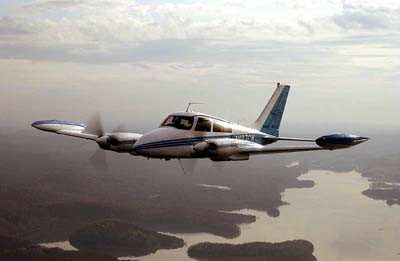Sat, Nov 26, 2011
Three Fatally Injured When Aircraft Went Down In Heavy Fog
The NTSB has issued its probable cause report in the February,
2010 accident which resulted in the fatal injury of three employees
of the Tesla automobile company and sparking fires in a residential
neighborhood. The board determined that the probable cause of the
accident was the pilot’s failure follow the standard
instrument departure as instructed, and his failure to attain a
sufficient altitude to maintain clearance from power lines during
takeoff in instrument meteorological conditions.
Cessna 310 File Photo

According to the report, the pilot of the Cessna 310
departed the airport in near-zero visibility instrument
meteorological conditions, and shortly after takeoff, struck a
power pole and power lines before impacting terrain. Review of
recorded air traffic control tower (ATCT) transmissions revealed
that the pilot was initially given his IFR clearance to turn right
to a heading of 060 degrees and climb to 3,000 feet. Shortly after
verifying his IFR clearance, the pilot received his IFR release
from the ATCT controller and was informed that the runway was not
visible to the controller. The controller further informed the
pilot that takeoff was at his own risk. Shortly after, the
controller notified the pilot that he had two minutes for his IFR
release, before it expired. The pilot stated that he did not hear a
"cleared for takeoff" instruction from the controller. The
controller responded that he could not clear the pilot for takeoff,
due to not having the runway environment in sight and that "the
release is all yours and it's at your own risk sir." The pilot
acknowledged the transmission and proceeded to take off. One
witness, who was adjacent to the accident site, reported that she
observed an airplane “suddenly appear from the fog”
left of her position. The witness stated that she continued to
watch the airplane fly in a level or slightly nose up attitude
until it impacted power lines.
Accident site evidence was indicative of a level impact with a
power pole about 50 feet AGL and at a high airspeed. All major
structural components of the airplane were located within the
wreckage debris path. Examination of the airframe, engines and
propellers disclosed no evidence of any preimpact mechanical
anomaly. Weather conditions reported five minutes prior to the
accident were wind variable at 5 knots, visibility 1/8th mile, fog,
and vertical visibility of 100 feet agl. Weather conditions
recorded by the ATCT 11 minutes after the time of the accident were
visibility 1/16th mile, fog, and a vertical visibility of 100 feet
agl.
Local law enforcement provided recordings from a sound recording
system, which captured the accident sequence. The recordings were
coupled with airport surveillance radar to interpolate a flightpath
for the airplane. The interpolated flightpath indicated an
approximate 45-degree left turn shortly after departure to the area
of initial impact with the power pole and power lines. A sound
spectrum study determined both engines were operating near full
power.
More News
Also: H55 Completes American Tour, Robinson Trade-Ins, Retired AV-8B Harrier, NS-35 Mission Organizers of the iconic annual Air Race Classic will soon be opening registration for t>[...]
Also: 500-Aircraft Deal With China, Florida ANG's F-35, FAA Denies Petition, UC Central Arkansas Aviation Academy The Reno Air Racing Association (RARA) is offering its apologies t>[...]
Also: Air Race Tkts Marked Down, Kirk Hawkins Lost, GADFLY AI-Driven Engine Analysis, Sport Aviation Halls of Fame The Aero-News crew is getting ready to pack up a lot of video gea>[...]
"This is just an absolute win win win. If there is a rejected takeoff we now have the confidence that the arrestor system will ensure passenger and crew safety." Source: FAA Admini>[...]
Low Approach An approach over an airport or runway following an instrument approach or a VFR approach including the go-around maneuver where the pilot intentionally does not make c>[...]
 Airborne 08.22.25: ARC Spinoff, Nat'l Championship Air Races, Hawkins Accident
Airborne 08.22.25: ARC Spinoff, Nat'l Championship Air Races, Hawkins Accident Airborne 08.27.25: Air Race Tkt Discounts, Europe AvGas, Deportation Flights?
Airborne 08.27.25: Air Race Tkt Discounts, Europe AvGas, Deportation Flights? Airborne Affordable Flyers 08.28.25: Midwest Av Expo, Vickers, Air Race Classic
Airborne Affordable Flyers 08.28.25: Midwest Av Expo, Vickers, Air Race Classic Aero-News: Quote of the Day (08.30.25)
Aero-News: Quote of the Day (08.30.25) ANN's Daily Aero-Term (08.30.25): Low Approach
ANN's Daily Aero-Term (08.30.25): Low Approach



